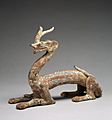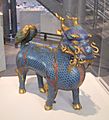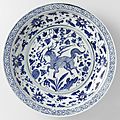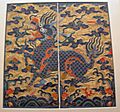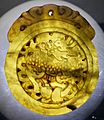Qilin facts for kids
The Qilin (pronounced "chee-lin") is a special mythical creature from Chinese mythology. It has hooves and is known in many East Asian cultures. People believed the Qilin would appear when a very wise person or a great ruler was about to arrive or pass away.
Contents
What Does a Qilin Look Like?
A Qilin is a mix of different animals, making it a "chimerical" creature. It has a single horn on its forehead, like a unicorn. Its belly is yellow, and its back has many colors. It has the hooves of a horse, the body of a deer, and the tail of an ox. The Qilin is known for being very gentle. It never walks on green grass or eats living plants, showing its peaceful nature.
Where Did the Qilin Story Begin?
The first Qilin is said to have appeared in the garden of the legendary Yellow Emperor (Huangdi) in 2697 BC. This was seen as a sign of the emperor's good and kind rule. About 300 years later, two Qilin were reported in the capital city of Emperor Yao. This also showed how good and fair Emperor Yao was as a ruler.
Qilin and Confucius
A Qilin also appeared to the pregnant mother of Confucius in the 6th century BC. Confucius became a very important Chinese philosopher. The Qilin coughed up a special jade tablet with writing on it, which was believed to predict Confucius's future greatness. Later, the death of Confucius was hinted at when a Qilin was accidentally hurt by a charioteer.
Qilin and Giraffes
In 1414, a real giraffe was brought to China for the first time. It was given to the Ming emperor Yongle. Some people tried to flatter the emperor by saying the giraffe was a Qilin. However, the emperor was smart and saw through this. He said he was not a sage (a wise person), and the animal was definitely not a Qilin. In Japanese, the word for giraffe is "kirin," which uses the same characters as Qilin.
Images for kids
-
Qilin with Rider, from the Oxford College Archives of Emory University
-
One-horned beast depicted in ceramic model from Northern Wei period (386–534)
-
A Ming-era painting of a tribute giraffe, which was thought to be a qilin by court officials, from Bengal
-
Plate with a qilin in the center, Yuan dynasty
-
Embroidered qilin, Qing dynasty
-
Kỳ Lân statues, Bat Trang kiln, Hanoi, Nguyen dynasty, crackle glaze ceramics – at the National Museum of Vietnamese History in Hanoi, Vietnam
See also
 In Spanish: Qilin para niños
In Spanish: Qilin para niños



